The MGA With An Attitude
HYDRAULICS TECH DAY - HT-201
January 12, 2002 - Naperville, Illinois
Photos and web page courtesy of Barney Gaylord
Click on small images for larger images.- Larger pics average 33KB.
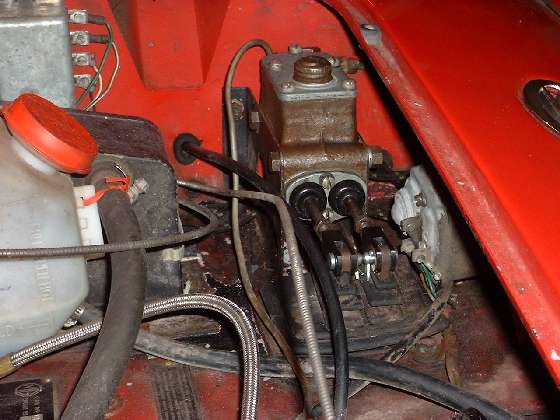
The main problem here was a leaky master cylinder, leading to some paint removal. The whole system was rebuilt just a few years earlier, but somehow the rubber seals didn't seem to be compatible with the hydraulic fluid. As a result the fluid was getting dirty and carrying lots of little bits of rubber, even though it was being flushed twice a year. The leaky master cylinder was the last straw, so all of the rubber packing pieces and hoses through the entire hydraulic system are being changed again. In the process the lines are being flushed through with alcohol for cleaning and blown dry before installing fresh fluid.
|
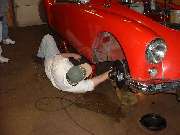 |
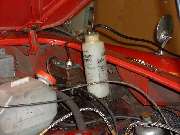 |
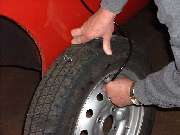 |
As we were going to be changing the fluid type, we started by blowing all of the old fluid out of the system, then flushing it through with alcohol, then blowing that out and then blowing it dry. The Gunson Eezibleed tool makes this part of the job a cinch. The only critical part is to be sure the screw caps are leak tight, and the input hose is attached to a nearby tire valve for the air pressure supply. Once the master cylinder is pressurized the fluid comes out of an open bleed nipple in a matter of seconds. The clutch slave and four wheels makes five bleed nipples. The old fluid was out in a minute or two after hookup. Most of a quart of alcohol was then flushed through the plumbing in about a minute. This was followed by blowing air through the lines to clear out the alcohol (continuing until the tire was flat).
|
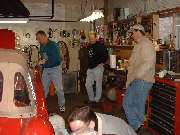 |
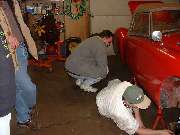 |
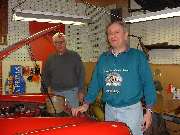 |
With plenty of hands available we could remove all of the cylinders and hoses in short order. This was followed by disassembly of the cylinders, cleaning, honing, cleaning again, and reassembly with all new cylinder repair kits, and reinstallation with all new hoses. Luckily the cylinders were all in good enough condition to hone out cleanly. This was expected, as the entire system had been rebuilt just a few years earlier. Reason for this exercize today was because of a leaky master cylinder, and dissatisfaction with fluid that was getting black and carrying lots of small rubber particles, even though it was being flushed twice a year. It appears that the repair kits installed last time around were not compatible with the DOT-4 fluid being used. Maybe the rubber bits had just been left on the shelf too long before installation. At any rate, the prior system had lasted more than 10 years with DOT-5 fluid and no problems, so this one is now going back to silicone fluid.
|
 |
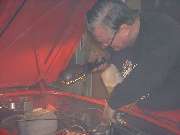 |
 |
A pressure washer wand running on high pressure air is almost as good as steam cleaning. The area around the offending master cylinder was first sprayed down with engine degreaser, then pressure sprayed with a solution of Mr.Clean to remove the dirt and spilled brake fluid, then finally pressure rinsed with clear water. The body area around the master cylinder shows the effects of peeling paint caused by the brake fluid. Luckily this car had a base coating of black epoxy paint before the colored surface paint was applied, so only the color coat was affected and the black epoxy paint was still in place, so no rust. The body paint will be touched up later (maybe). The master cylinder in the picture above is now sporting new gaskets and seals, new clevises and clevis pins for the pushrods.
|
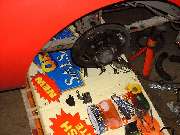 |
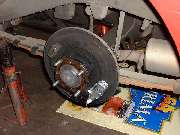 |
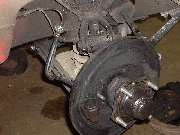 |
The rear brakes are also getting a new hand brake cable, along with new equalizer pivot stud and bushing and other new hardware. The right side shows the slave cylinder removed. Left side shows duct tape around the cylinder to retain the piston while the system was being pressure flushed. The third photo above shows an interresting accessory on the right front wheel. This is a hall effect sensor used as input for a rally computer. There are two bar magnets epoxied to the bearing hub (one visible). The sensor looks like the end of a threaded bolt attached to the brake backing plate with a pair of jam nuts. The lead wire from the sensor runs along the brake hose and is attached there with a few small tie wraps.
|
|
|